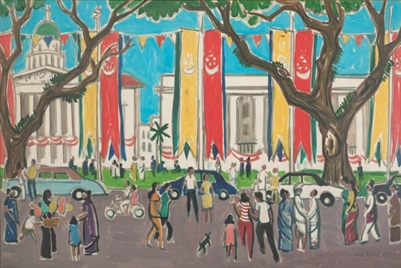Although their art has been influenced by many different cultures, there is one culture that dominates their art. Chinese immigrants who moved to Singapore introduced calligraphy, sculptures, and the art of porcelain, many of which are based on the Nanyang art styles. This form was highly dependent on expressionism but also used folklore and indigenous beliefs as part of their art.
 |
| example of Nanyang style |
The turbulent times after WWII was a major blow to all of the cultural arts.
For the most part, it was nonexistent as Singaporeans rebuilt their country. As
they moved into independence, multiculturalism was a prominent theme. Soon, the
acceptance of the commercialism of public and private art crescendoed into an
explosion of Singaporean artists creating art on a world stage.
 |
| by Ng Woon Lam |
Today, Singaporean art takes in all modern art movements of its many ethnic
groups found in this small country. It has become a hub of Asian and European
art. Some artists include Chua Ek Kay
(thought of as the "bridge between Asian and Western art," uses many
Chinese-style techniques), Cheong Soo
Pieng (prominent artist in the Nanyang style, helped drive modern art), Georgette Chen (known for
Post-impressionism), Ng Eng Teng
(known as the Grandfather of Singapore Sculpture), Lim Tze Peng (artist and teacher, awarded Cultural Medallion in
2003), Ho Ho Ying (known for
avant-garde Chinese calligraphy and Abstract Expressionism), and Ng Woon Lam (member of National
Watercolor Society and American Watercolor Society).
 | |
| by Ho Ho Ying |
Literature in Singapore is generally written in one their four languages:
English, Mandarin Chinese, Tamil, or Malay. There is a strong tradition for the
written word in Singapore, but it doesn't necessarily mean traditional novels,
poetry, and written text. It also includes spoken word and performance art.
Many of the Chinese immigrants to Singapore brought their poetry with them, and it certainly has been a medium for choice for many of the Chinese living there. Soon, writers began to publish modernist poetry in English, the first of which (Teo Poh Leng's "F.M.S.R") was possibly published in London in 1937 under the pseudonym Francis P. Ng.
After Singapore gained its independence, there was a renewed push in literature. Several writers emerged and led the way, embracing expressionist styles and not only publishing their works in Singapore but the world. Writers began to produce poems, novels, and plays about the life and culture of Singapore as well as address intimate or taboo topics like sexuality, social issues, and gay rights.
Genres like children's literature, science fiction, graphic novels, and drama are growing in popularity for writers. Several writers have won numerous awards for their work in these genres, even making it on the international stage. A few notable authors include Pao Kun Kuo (playwright, founded three arts and drama centers), Haresh Sharma (playwright, has written more than 100 plays), Catherine Lim (fiction writer, touching on themes about Chinese culture in Singapore society), Michael Chiang (often considered one of the more successful playwrights), Goh Sin Tub (wrote numerous novels and short stories in Malay), Goh Poh Seng (novelist, playwright, poet, also has a medical degree), Ng Yi-Sheng (poet and writer, won awards for his work on LGBTQ in Singapore), among many others.
Up next: music and dance




No comments:
Post a Comment